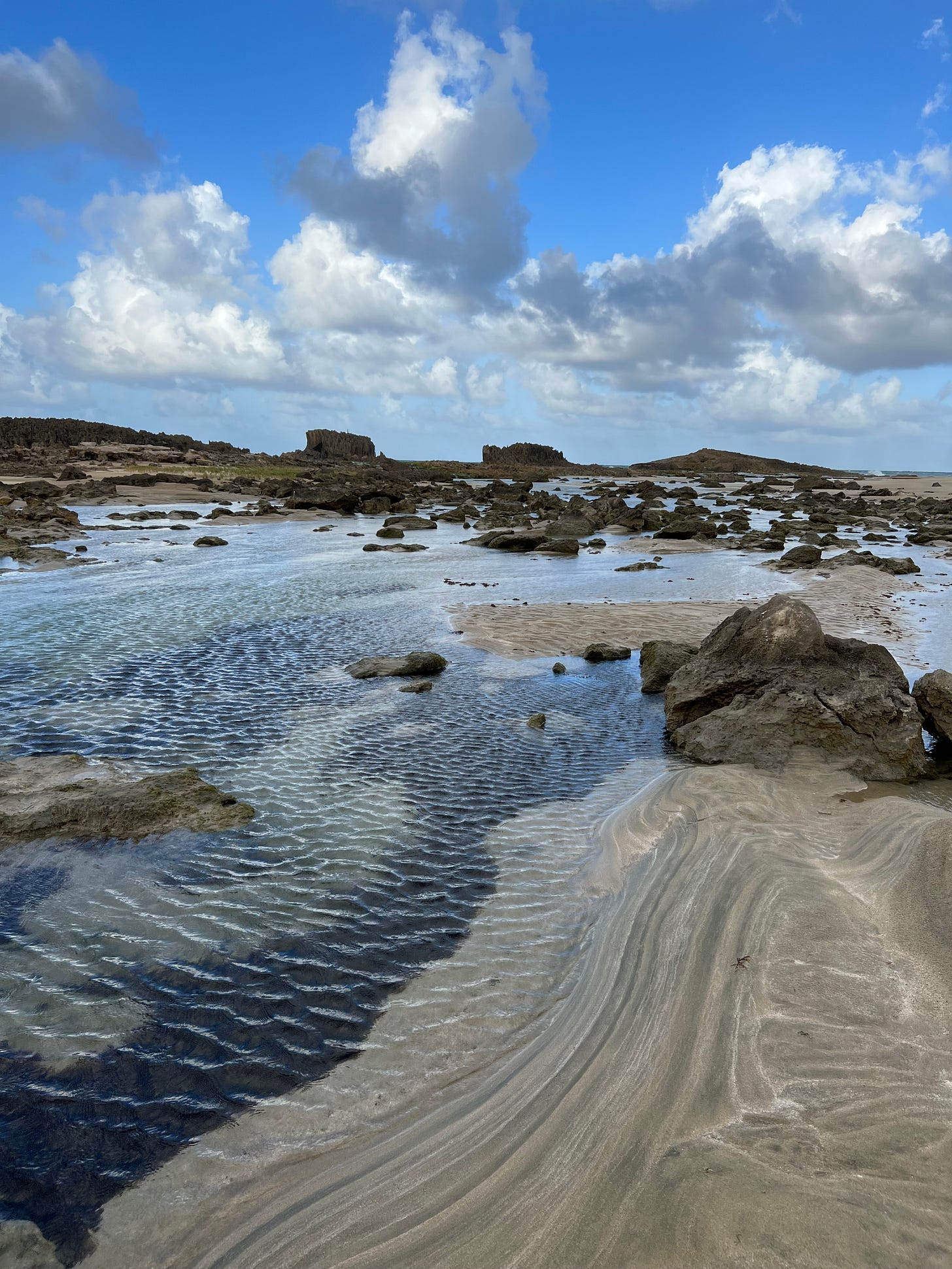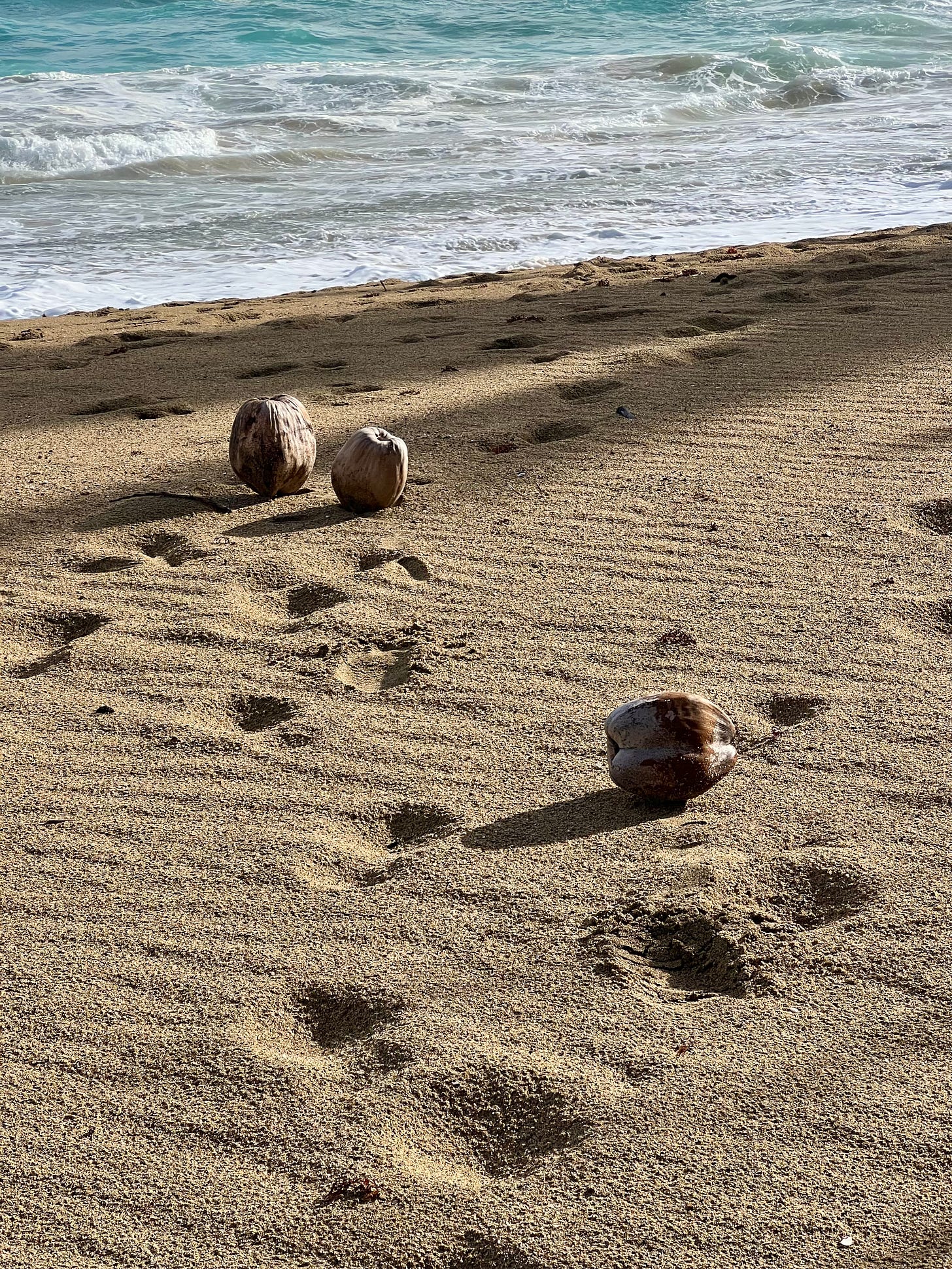I hear a groan behind me as my feet, clad in rubber soles, push their way through mounds of mushy sand. The sound is not coming from waves bumping into wet boulders or crests beating against an old railroad track seawall.
It’s from Mark. “Ugh.” I know what’s going on. And his next line is even more predictable. “I hate sand in my shoes.”
I turn and watch as my husband shakes sand from his water shoes—designed to allow sand to sift through—and slough any remaining grains off his feet.
The rising sun pierces the cresting waves. Warmth trickles through my veins from what I perceive to be his scorn for my passion.
Sand.
My husband doesn’t get sand. Literally, yes. Figuratively, no. He doesn’t understand its purpose, and I suggest he might prefer for there to exist only grassy shore and ocean flats and skip the part in between.
Sand happens, I remind him, when rocks break down, after batterings by waves and wind and wily feet like ours. Does he not know how rocks take time to decompose into more dramatic seascapes worthy of a photo? Their beginnings may point to origins thousands of miles away from the ocean, meandering down lazy rivers and sinking in streams. And they eventually break into bits and pieces. Like some humans who take time break down and allow life to pour through. A lot like me.
My earliest memory of sand is from my father’s garden. Growing up in northern Ohio, our backlot contained sand at the base. Which made for some very rich tomatoes, plump, juicy, almost tasting of the sea in which the sand might have been born. I now live where clay clogs up the soil. No tomato rivals those grown in the grit my father’s hands shoveled through.
My parents often took us kids to Lakeview Park, in Lorain, Ohio. Playing in sand was one way to avoid my siblings or ignore my pudgy legs. After the beach was cleaned up by the Army Corps of Engineers, it’s now become a destination, including a stop on my itinerary whenever I’m in town. Whether the sand holds my feet in its cold embrace, or a bowl of warmth, it doesn’t matter. I am at home with my feet dug in.
My hometown of Amherst was nicknamed the Sandstone Capital of the World, due to its sandstone quarries. The front lawn of Amherst City Hall houses the millstone to prove it. Perhaps sand runs through my blood, coursing as freely as tomatoes and wine and cheese. When out of town, I brag about my connection to sandstone. I’ll always point to a historic building when I recognize its construction of sandstone. According to rumor, Bill Gates once installed Amherst Sandstone in his home. For the façade of a home we built, I selected a faux-sandstone option called Amherst. Sand was everywhere in my life. Even as a kid when our family drove to Florida, I didn’t mind sand stuck to my youthful, sunburnt cheeks in the shower. I carried some sediment on my person and carried the sentiment of adventure home.
Though Mark doesn’t mind playing coconut bocce as we stroll up and down an empty beach, I just can’t convince him to love sand as I do.
Yet, when he and I discuss the beaches of the world we’ve visited, he mentions he should have started a sand collection. You’ve seen them in people’s homes, the little vials of sand, clearly marked, carried home with care and kindness, reminiscent of a memory. Ironic how the person who complains most about sand is the person who wants to collect it, contain it.
I attempted to contain sand—once. On my final day as a resident of Oregon, before moving to Ohio, I grabbed an old mason jar that probably had held tomato sauce my mother made for us. It was just big enough. Halting the progress of the movers, I ran down to the shore and scooped a generous portion of sand, leftover dried algae included, into the jar. The jar exists still, buried somewhere in my son Davis’ bins. I thought, if he never went back west, we would always have the sand as our measure of time there—then, he went back.
Should I go looking for that jar and return to the sea what belongs to the sea?
Often, Mark is the one returning the contents of his shoes or shorts to the sea. As for me, I’m charmed by emptying out a backpack, sand pouring forth, wondering which beach, ocean, stretch of wet-dry it came from. I leave these little pockets of the sea to live on my suitcase for the next time and the next and the next. It’s like a surprise before and after every trip.
Mark isn’t alone in not liking sand. When interviewed by Brené Brown, Adam Grant, author of Think Again, talks about growing up surrounded by lakes. “I’ve never understood why people like the ocean,” he tells Brené. “It’s cold, its salty, its sharky. It’s supposed to be freshwater, and really warm in the summer with no dangerous animals.” Brené agrees. “I’m a lake girl and I don’t get sand. We don’t need it.” Adam speaks for Mark here, summing up his sentiments. “When we’re not with our kids, sand is right up there with glitter for me. Didn’t need to be invented.”
Perhaps Mr. Grant should “rethink” sand.
Is sand uncomfortable? Yes. The truth is we should all stand on shore and stare at oncoming waves with the knowledge that life is a little unnerving. Stand before the grandest of flows until we feel something—other than wet, which is not an emotion. However, a speck of sand in the shoe that prompts us to pay attention—to not be lulled into false sense of beauty—is.
That moment is not the last I will hear of Mark’s sighs. We will follow the sandy lines of the northern coast of Puerto Rico where the rugged remains of sand remind me just a little of Oregon Coast, and one or two beaches where the flat terrain might conjure Italy during a particularly amazing bike ride, and one length of sea grapes tangled with mangroves whose smell reminds me of Dad, watering the garden late at night, no algae or sea creatures floating nearby. Just the scent of summer in the air, tomatoes on the vine, and time on my father’s hands to speak with me.
A speck of sand contains multitudes. Of struggles, of joy. I’m not throwing any of them away. Maybe that little speck stuck in Mark’s shoe means he gets sand after all. Why else would he buy a bag of it to host the hermit crab he “accidentally” carried home from vacation?
What’s the line you draw on sand? I’d like to know! Leave a comment below.







Very enjoyable!!! My feet always choose a beach and I follow!!!
I grew up a "lake girl" but loved the ocean (AND the sandy beach) as soon as I met them. Nothing beats walking along the ocean's edge, watching your footprints instantly disappear behind you. I cannot be forced to choose, though. Each environ has its charm.